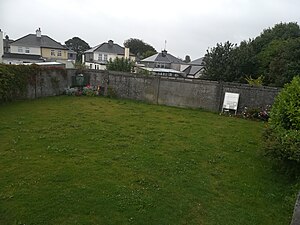Mother and Baby Homes Commission of Investigation
 |Mount Carmel Medical Center, Columbus, Ohio-2011 07 12 IMG 0870-->|thumb]]
|Mount Carmel Medical Center, Columbus, Ohio-2011 07 12 IMG 0870-->|thumb]]
Mother and Baby Homes Commission of Investigation was a commission established by the Government of Ireland to investigate into the treatment of women and children in Mother and Baby Homes and certain other related institutions during the period from 1922 to 1998. The commission was set up in response to allegations of abuse and mistreatment of residents within these institutions, which were primarily run by religious orders. The investigation was part of a broader effort to address historical injustices in Ireland's social history.
Background[edit | edit source]
The establishment of the Commission was prompted by the discovery of mass graves at the site of the former Bon Secours Mother and Baby Home in Tuam, County Galway. This discovery, made public in 2014, led to widespread public outcry and calls for a comprehensive investigation into the practices of similar institutions across Ireland. These homes were intended for unmarried pregnant women to give birth in secrecy, away from the stigma associated with unwed motherhood in predominantly Catholic Ireland. After giving birth, many women were separated from their children, who were often adopted, sometimes without the mother's consent.
Mandate[edit | edit source]
The Commission's mandate included the investigation of the living conditions, care arrangements, and post-birth practices within these homes. It also looked into the circumstances surrounding the entry of women into these homes and the subsequent fate of their children. The investigation covered not only the mother and baby homes but also a number of so-called County Homes, which took in a wider range of residents, including elderly and disabled people.
Findings[edit | edit source]
The Commission's final report, published in January 2021, detailed significant findings of widespread mistreatment, high mortality rates among infants, and forced adoption practices. It also highlighted the role of the state, society, and the church in the operation of these homes and the stigmatization of unmarried mothers and their children. The report concluded that approximately 9,000 children died in these homes during the period under investigation, representing about 15% of all children who were born or lived in the homes.
Reactions[edit | edit source]
The publication of the report elicited a wide range of reactions. Survivors and advocacy groups expressed disappointment, feeling that the report did not fully acknowledge the extent of the harm done or the responsibility of the church and state. The Irish government formally apologized to the survivors, acknowledging the failure of the state to protect the most vulnerable members of society. Discussions on how to provide reparations and memorialize the victims are ongoing.
Legacy[edit | edit source]
The Mother and Baby Homes Commission of Investigation has shed light on a dark chapter of Ireland's past, prompting a national reckoning with issues of institutional abuse, women's rights, and societal attitudes towards unmarried mothers and their children. The findings have led to calls for further research, the preservation of records, and measures to ensure such injustices are never repeated.
This commission related article is a stub. You can help WikiMD by expanding it.
Search WikiMD
Ad.Tired of being Overweight? Try W8MD's physician weight loss program.
Semaglutide (Ozempic / Wegovy and Tirzepatide (Mounjaro / Zepbound) available.
Advertise on WikiMD
|
WikiMD's Wellness Encyclopedia |
| Let Food Be Thy Medicine Medicine Thy Food - Hippocrates |
Translate this page: - East Asian
中文,
日本,
한국어,
South Asian
हिन्दी,
தமிழ்,
తెలుగు,
Urdu,
ಕನ್ನಡ,
Southeast Asian
Indonesian,
Vietnamese,
Thai,
မြန်မာဘာသာ,
বাংলা
European
español,
Deutsch,
français,
Greek,
português do Brasil,
polski,
română,
русский,
Nederlands,
norsk,
svenska,
suomi,
Italian
Middle Eastern & African
عربى,
Turkish,
Persian,
Hebrew,
Afrikaans,
isiZulu,
Kiswahili,
Other
Bulgarian,
Hungarian,
Czech,
Swedish,
മലയാളം,
मराठी,
ਪੰਜਾਬੀ,
ગુજરાતી,
Portuguese,
Ukrainian
Medical Disclaimer: WikiMD is not a substitute for professional medical advice. The information on WikiMD is provided as an information resource only, may be incorrect, outdated or misleading, and is not to be used or relied on for any diagnostic or treatment purposes. Please consult your health care provider before making any healthcare decisions or for guidance about a specific medical condition. WikiMD expressly disclaims responsibility, and shall have no liability, for any damages, loss, injury, or liability whatsoever suffered as a result of your reliance on the information contained in this site. By visiting this site you agree to the foregoing terms and conditions, which may from time to time be changed or supplemented by WikiMD. If you do not agree to the foregoing terms and conditions, you should not enter or use this site. See full disclaimer.
Credits:Most images are courtesy of Wikimedia commons, and templates Wikipedia, licensed under CC BY SA or similar.
Contributors: Prab R. Tumpati, MD


